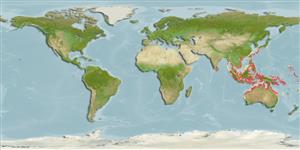>
Tetraodontiformes (Puffers and filefishes) >
Monacanthidae (Filefishes)
Etymology: Paramonacanthus: Greek, para = the side of + Greek, monos = one + Greek, akantha ) thorn (Ref. 45335).
More on author: Bleeker.
Environment: milieu / climate zone / depth range / distribution range
Ecologia
marinhas demersal; intervalo de profundidade 3 - 25 m (Ref. 90102). Tropical
Western Pacific: Thailand, Malaysia, northwestern Australia, Philippines, Indonesia, and New Guinea.
Tamanho / Peso / Idade
Maturity: Lm ? range ? - ? cm
Max length : 11.0 cm SL macho/indeterminado; (Ref. 33065)
Descrição suscinta
Chaves de identificação | Morfologia | Morfometria
Espinhos dorsais (total) : 2; Raios dorsais (total) : 27 - 31; Espinhos anais: 0; Raios anais : 28 - 32; Vértebras: 19. Dorsal profile of snout straight to convex in male, small hump sometimes over or slightly in advance of nostrils; straight to concave in female and juvenile, without hump. First dorsal spine originating over posterior half of eye, or slightly behind eye. With dark brown to dusky blotches, sometimes tending to form two curved, oblique stripes on body, first from rear of soft dorsal fin to pectoral fin, second from caudal fin base to ventral flap; three dark brown blotches nearly always present.
Inhabits sheltered coastal reefs, usually forming small aggregations (Ref. 48637). Also found in mud and sand bottoms of trawling grounds (Ref. 90102).
Ciclo de vida ou comportamento de acasalamento
Maturidade | Reprodução | Desova | Ovos | Fecundidade | Larvas
Hutchins, J.B., 1997. Review of the monacanthid fish genus Paramonacanthus, with descriptions of three new species. Rec. West. Aust. Mus. Suppl. No. 54:1-57. (Ref. 33065)
Status na Lista Vermelha da UICN (Ref. 130435: Version 2024-2)
Ameaça para os humanos
Harmless
Uso pelos humanos
Ferramentas
Relatórios especiais
Baixar XML
Fontes da internet
Estimates based on models
Preferred temperature (Ref.
123201): 25.2 - 29.3, mean 28.6 °C (based on 2286 cells).
Índice de diversidade filogenética (Ref.
82804): PD
50 = 0.5000 [Uniqueness, from 0.5 = low to 2.0 = high].
Bayesian length-weight: a=0.01995 (0.00956 - 0.04164), b=2.93 (2.76 - 3.10), in cm total length, based on LWR estimates for this (Sub)family-body shape (Ref.
93245).
Nível Trófico (Ref.
69278): 3.1 ±0.3 se; based on size and trophs of closest relatives
Resiliência (Ref.
120179): Elevada, tempo mínimo de duplicação da população menor que 15 meses (Preliminary K or Fecundity.).
Fishing Vulnerability (Ref.
59153): Low vulnerability (10 of 100).
